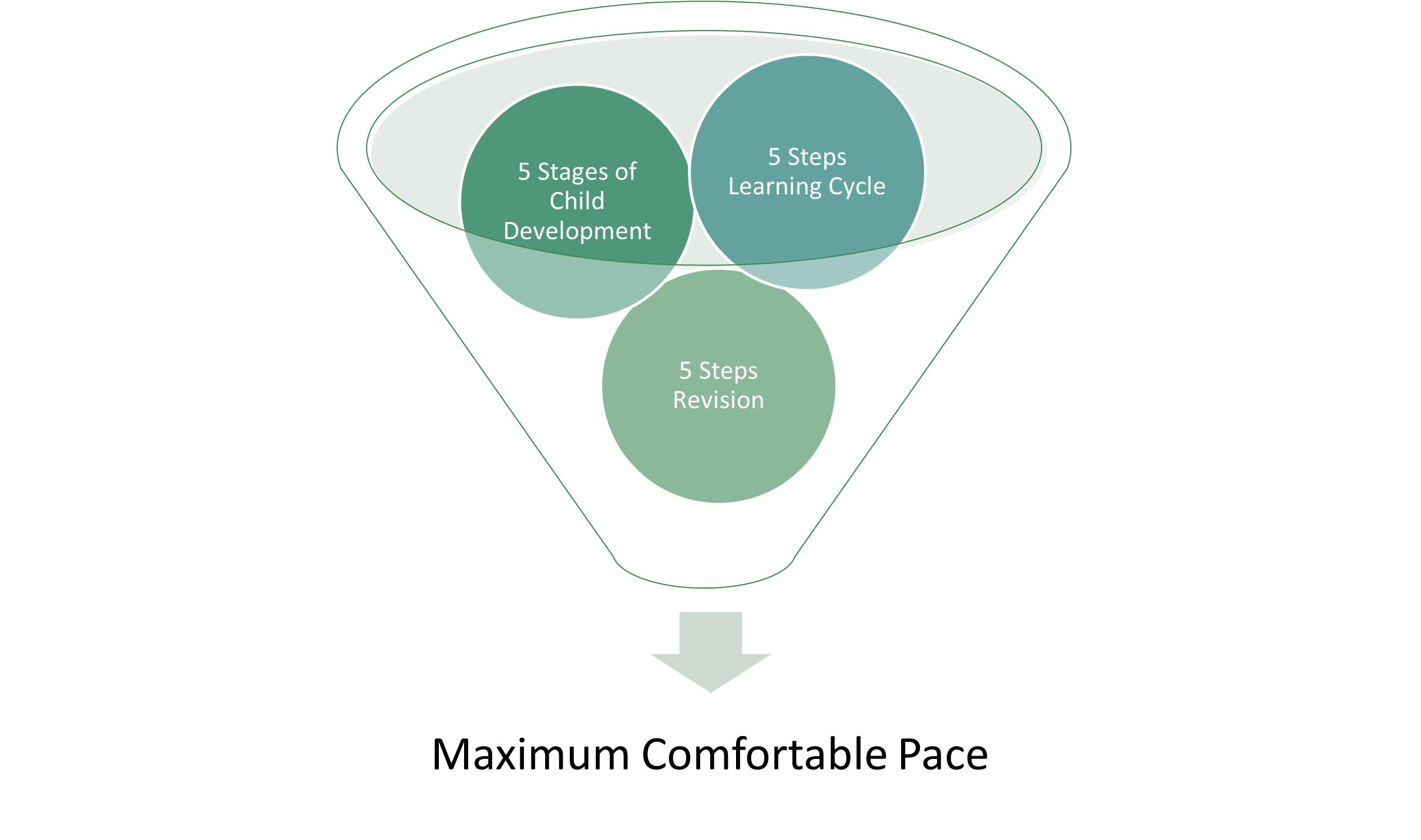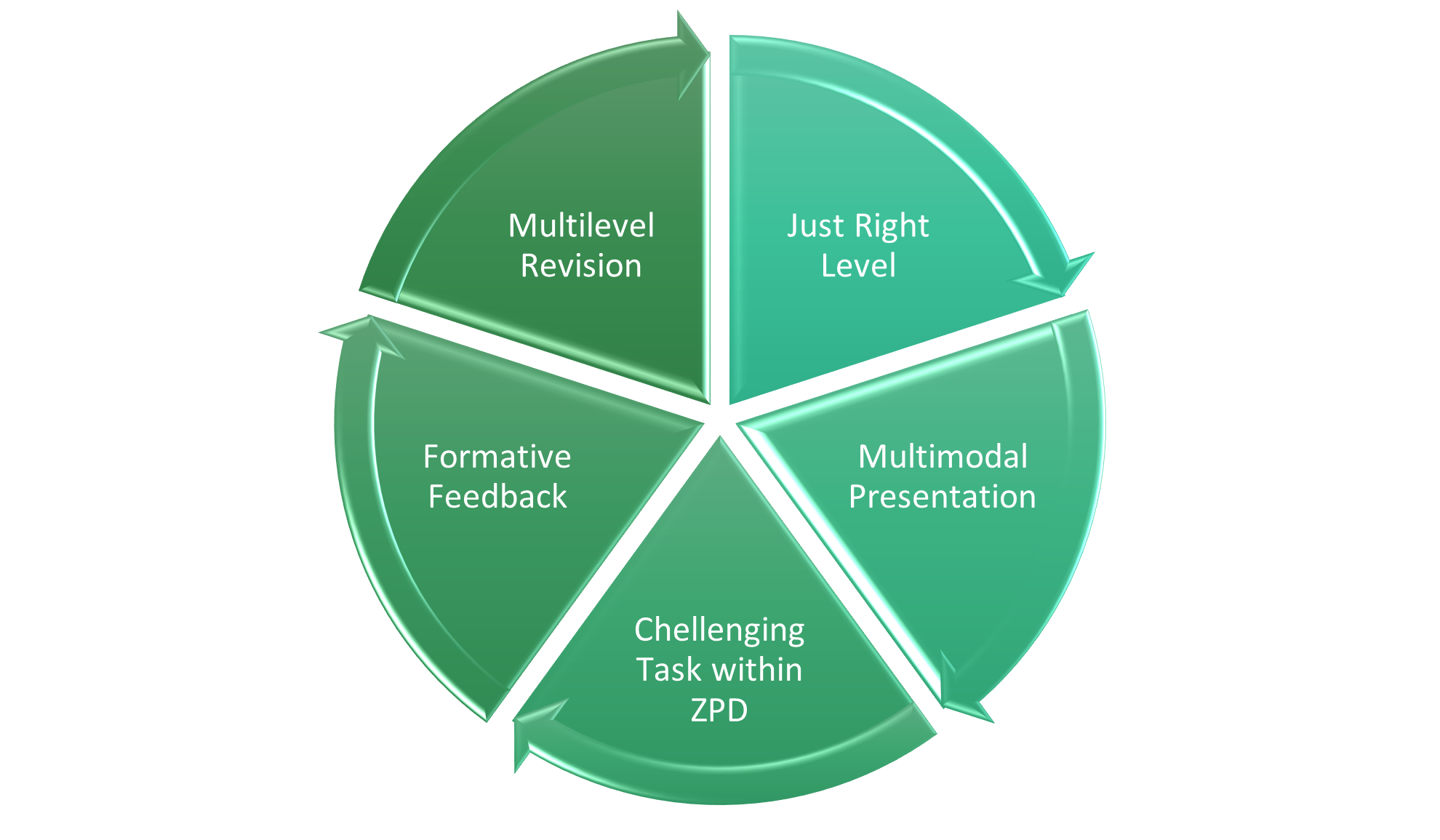5 Steps System™
The 5 Steps System™ is based on the rational use of age-appropriate characteristics of the stages of the child’s development with the main goal of accelerating their mastery of school curriculum. The core of the 5 Steps System™ is the right allocation of time given to each subject, taking into account the child’s age, learning style, and preferences, combined with innovative approaches to the learning process.
The 5 Steps System™ is an evidence-based teaching methodology that focuses on using learners’ time in the most efficient way with the highest rates of knowledge and skills retention.
The following scientific findings with strong level of evidence (not anecdotes) inform 5 Steps teaching strategies and techniques.
5 Steps Academy research
Cambridge Assessment International Education Guidelines
John Hattie: Visible Learning
Educational Endowment Foundation: Teaching and Learning Toolkit
Robert Marzano/ Ceri Dean: Classroom Instruction That Works
International Academy of Education: Principles of Instruction
Institute for Educational Sciences: Organizing Instruction and Study to Improve Student Learning
The 5 Steps System™ has three components:
- 5 Stages of Child Development
- 5 Steps Learning Spiral
- 5 Steps Revision

All three components add up to achieving the maximum but comfortable personal progress speed for every child to make their educational journey the most efficient and enjoyable.
The Development component determines the most effective allocation of time in studying various subjects of the curriculum. The Learning Spiral and Revision components determine the principles of study for each subject. Each component is personalized for every student.
Development Component
Assigning subjects time priorities within the framework of the 5 Steps System™ looks like this:
Step One—mastering languages. Preschool is the ideal age for this. During this period, the child’s mind is most receptive to learning any language you want him to learn. His fluency in English opens access to a variety of educational resources, including mobile applications, video, and textbooks. What’s more, at preschool age the leading psychological activity is the formation of social skills. This pairs very well with the methodology for teaching languages in the younger group at the School.
Step Two—mastering mathematics. Elementary school is the best age. In this “latent” period children are plunging into discover the world, the leading psychological activity is forming complex intellectual networks. Math lessons during this period will, to a significant degree, determine the future intellectual abilities of the child. Besides that, math mastery and a command of logic will make student understanding of other subjects considerably easier, greatly accelerating their learning.
Step Three—mastering the “Science” block: physics, chemistry, and biology. 10–12 years old is the best age for this step. By this time, students at the School have already, as a rule, mastered the School’s mathematics curriculum, and are prepared to complete the study of all three subjects of the “Science” block in 1–2 years, freeing up school hours for the most important subjects of Step Four.
Step Four—mastering world history and world literature. The ideal period for starting Step Four is 12 years old. True history is content rated, at the very least, for 12+ audiences. Concerning literature, questions posed in the masterpieces of classical literature generally hold little interest for children younger than 12 years old. Similarly, students of the School in their teenage years have freed up a significant amount of time by mastering the subjects of the previous Steps. They have the opportunity to almost completely immerse themselves in the world of history and literature.
The School does not select classics based on country of origin but rather based on its place in the world literary heritage. Byron, Shakespeare, Mark Twain, and Fitzgerald are studied alongside while Tolstoy, Lorca, Ibsen, and Brecht. The same with world history.
Step Five—exams and testing preferences. 14–17 is the best period. At this time students normally take the Cambridge exams, study various introductory courses in online universities in areas of interest to them, so they can better familiarize themselves with their options for future specialization. Students choosing a direction may begin studying remotely in the best universities of the world and can even receive their bachelor’s degree through distance-learning technologies. After that, with a bachelor’s degree, a student may either continue his full-time education for a Master or Doctor of Science, change his direction, choosing a different specialization, or go to work in his chosen field.
So, by the age of 16–18 years old, students at the School are deeply and diversely educated, have degrees from the world’s leading universities, and can make a conscious and highly informed choice about their future path.
Emphasizing a subject at each level simply indicates priorities, the Stages intersect and overlap, especially for students enrolled at the School in their teenage years.
Learning Spiral Component
5 Steps Learning Spiral ensures that 5 Steps Academy teachers use innovative evidence-based techniques to help kids master concepts in the most time-effective way.

1. Just Right Level
This step is especially important for new students who naturally feel a bit anxious in unfamiliar environment. Within first few days in the school students discover that almost every concept is familiar to them, and tasks are easy to complete. Then teachers link new concepts and skills to prior knowledge to make students feel comfortable and create strong neural patterns.
2. Multimodal Presentation
At 5 Steps, teachers use various presentation methods to grab and hold students’ attention as well as to cater for students’ unique blends of perception modes.
3. Challenging Task within ZPD
Every student at different stages of mastering the Syllabus has their unique Zone of Proximal Development (ZDP). The tasks above this zone can be frustratingly challenging for the child and they can easily lose motivation and (what’s more important) self-confidence (that’s what happens with slow thinkers in traditional classrooms with lecturing style of teaching). The concepts below the zone are already mastered and kids waste their time and get bored and lose motivation (that’s what happens with talented students in traditional classrooms with lecturing style of teaching where they are holed back by the average group pace).
In 5 Steps Academy, every child progress at their own maximum comfortable pace according to their individual learning plans.
4. Formative Feedback
Every 5 Steps student has his own personalized grading test dates for every subject. Moreover, we arrange multiple intermediate (formative) assessments to identify weak areas (areas for improvement – AFIs) and provide individual and timely support accordingly. AFIs and individual support plans (and other valuable information) is reflected in individual progress files, shared with parents, and updated overnight.
5. Multilevel Revision
This is one of the most critical areas. If dove right, multilevel revision will save a lot of student time and prevent frustration. Let’s consider this in detail.
Revision Component
Content-wise, the core of the 5 Steps System™ approach is the idea that material is studied in large chunks, about 2–3 grades at once, but we go layer by layer, from the easiest skills to the most difficult concepts of the same learning area.
Benefits include:
- A high speed for mastering the material, which in and of itself increases the student’s motivation;
- A maximum number of repetitions and improved comprehension, as the same concepts appear several times to the student in diverse contexts and with various connections;
- A broad perspective of the material within the context of the entire unit positively influences both motivation and the depth of mastery;
- A clear understanding of key concepts and lasting foundational skills will greatly facilitate the solution of complex problems in the future;
- Control of mastery at each Step and the realization of a student’s creative potential by applying knowledge already mastered in Step Five of each unit.
In Step One, the easiest points and most basic skills of a subject are studied: for Math—numbers and their operations, for languages—words, for History—major historical events and leaders, etc.
In Step Two, basic patterns and structures are studied, for example, the basic grammar structures and frequent phrases of a language.
In Step Three, students integrate basic skills, patterns, and structures from earlier steps in familiar contexts. For example, in History, students consider one or another major historical event within the context of world history.
In Step Four, multi-step problems and patterns are studied. For example, in math, there is a large variety of standard problems on percentages within the school curriculum. In History, studying the reasons one or another phenomena or event occurs, analyzing the historical process.
Step Five is creative. Here students solve research problems and study heuristics, techniques for solving problems. For example, in Math, students calculate the changes in the frequency of cars passing by throughout the day at a certain point in the city and subsequently construct a statistical model of the Poisson distribution, or, younger students create a table of the amounts and costs of a family’s weekly food consumption of groceries. For languages, students write essays. For History, researching information, preparing a report on the subject of “Interesting and Little Known Facts about . . .” As for heuristics, students learn to manage their own line of thinking, their “metacognition” is developed.
In each subject all five Steps are mastered in order, beginning with the first to the extent of a given level (sections of the subject). For example, in elementary mathematics, there are five such levels (about 2–3 grades combined). The study of each subsequent level begins with Step One after completing Step Five of the previous level.
One of the main advantages of the 5 Steps System™ is a child’s motivation to learn. The source of this motivation is not only the unique method of mastering the material but also the rapidity with which he gains knowledge. That feeling of quickly expanding your scholarship and multiplying your skills generates enough energy to overcome learning difficulties. The experience of gaining intellectual muscles provides students of the School a significant part of the necessary concentration and perseverance to actively participate in the educational process.
Students have the opportunity to experiment with their chosen life path as teenagers because they earn internationally recognized certificates of secondary education. We help them to do this, using online education opportunities offered by the best universities in the world, like Open University (UK) and Harvard University (USA).
One more advantage of using the 5 Steps System™ is the significant shortening of the gap between the physiological, social, and intellectual maturity of a child, which considerably lowers the risks of him being influenced by “bad friends”, of loss of motivation for school in his teenage years, and other manifestations of anti-social and/or irresponsible behavior. Usually at 13–14 years old a child psychologically “goes outside,” parents often lose their influence over the child. 5 Steps Academy students at this age are not only provided “good friends” from among their enthusiastic peers but also have the opportunity to continue their education, as determined by their personal choice, in universities abroad, while remaining at home.
Please click School Fees and Academic Courses for more details.
As seen on
![]()
Please find us in the list of the Best International Schools in Singapore